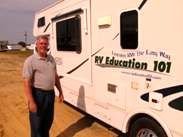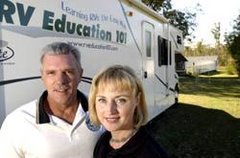There are lots of things to do and see in the wintertime; beautiful winter scenery, snow skiing, hunting, riding snowmobiles and much more. It’s no wonder so many people enjoy using their RV’s year round. When winter approaches each year I get numerous e-mails requesting information about using RV’s in cold temperatures. One reason I haven’t written on this subject in the past is because it would require more than just a short article to thoroughly cover this topic. Another reason for not writing about this in the past is that there are no guarantees that your RV can or will be 100% protected from the harsh winter elements by following written advice on the subject.
What I can do is offer you some suggestions and ideas that will help to protect your RV if you plan to use it during the cold winter months. I just can’t guarantee that it will be 100% protected. These suggestions and ideas are for short term winter camping in your RV. If you plan to take extended RV trips in cold weather there are many other precautions and measures that need to be considered, like using insulated skirting around the bottom of the RV for example.
Note: What we will be concentrating on in this article is how to protect your RV during cold weather camping. It is extremely important that you also understand how to protect yourself and other campers in cold temperatures.
One of the first considerations for cold weather RVing is if you will be traveling in temperatures below freezing. If this is the case, and there is water in the RV water system, your plumbing lines or water heater tank could freeze, resulting in costly repair bills, not to mention ruining your winter wonderland RV trip. To avoid this from happening I travel with the water system winterized. It is actually much easier to winterize an RV than most people think it is, and it’s not very expensive either. I have winterized and de-winterized our RV as many as four times in one winter.
The good news is it is still possible to use the bathroom facilities when you are traveling with the RV winterized. We take one gallon jugs filled with water to use in the toilet, and if your holding tanks are not heated you can put some RV antifreeze in the holding tanks to prevent the contents from freezing. Add the RV antifreeze (1-2 gallons) through the toilet for the black water holding tank and down the shower or tub drain for the gray water tank. The antifreeze will also protect the shower or tub P-trap which is usually located below floor level. The amount of antifreeze required for the holding tanks will be based on the size of the tanks, and it will be necessary to add more RV antifreeze as waste water is added to the tanks to prevent the antifreeze from being diluted.
Don’t allow the holding tanks to fill completely, before emptying them, during cold weather camping. This will reduce the chance of freezing, resulting in damage to the holding tanks. Take bottled water along for drinking and other needs like cooking, washing up and brushing your teeth when the RV is winterized. We have a five gallon jug that we always take on trips, filled with tap water from our house, for our pet’s drinking water and our other needs. This comes in handy when the RV is winterized.
When we arrive at our destination I try to select a site that will be exposed to the sun throughout the day, but also where there is some type of wind break available. Position the RV on the site so the front or rear will be facing the brunt of any wind, not the side of the RV. If there is an electrical hook-up I de-winterize the water system so we can use everything. All of the water lines in our motorhome are in a heated space, so we don’t need to be too concerned about the water system freezing as long as the RV has heat. We leave the water heater turned on whenever the water heater tank is full so there is no chance of it freezing. Some water heaters operate off of LP gas and electricity. Keep in mind if it’s in the electric mode it will use 9 to 13 amps.
It’s important that you know where all of the plumbing on your RV is located. Some RVs have heat ducts going to the basement storage areas where the water system is exposed to outside temperatures, but many RVs do not. If portions of the RV water system are below floor level, in areas that are not heated, it is possible for it to freeze and damage the water lines. If you are hooked up to an external water supply one option is to leave a faucet in the RV dripping, to keep the water moving, and decrease the possibility of water lines freezing. Another option is to use heat tape to protect the exposed water lines. Heat tape can be purchased at most hardware or building supply stores. Make sure it is suitable for the types of water lines in your RV, and if you plan to use it on a water hose.
If it is extremely cold outside and the possibility exists that the outside water supply could freeze, or if the campground water supply is shut off for the winter, I fill our fresh water holding tank and use it for all of our water requirements. Again, keep in mind where your fresh water tank is located; ours is in a heated area. If the campgrounds shower facilities are still open it’s a good idea to use them to avoid the gray water holding tank from filling so quickly. In this situation it might be in your best interest to keep the RV winterized and just use the campgrounds facilities.
The best source for heat is to use the RVs forced air furnace. There are a couple of things you need to be aware of when you use the RV furnace. First of all it will consume more LP gas than any of the other LP gas fired appliances. The LP tank or cylinders should be full before leaving on your trip, and you will need to monitor the LP gas supply carefully during your stay. Second, if you are not plugged into an electrical supply the furnace fan can quickly drain the auxiliary battery(s). Batteries that are not fully charged in cold temperatures can freeze resulting in not being able to use the RV furnace. I recommend that you plan your stay where you have access to an electrical supply when camping in cold weather. When we are plugged into electricity we set the forced air furnace on a low setting, around 60 degrees, and supplement the heat with thermostatically controlled ceramic heaters. These heaters work extremely well and you don’t need to be concerned about a fire or carbon monoxide.
Caution: Carbon monoxide is deadly. You cannot see it, taste it or smell it. Never use your range burners or oven as a source of heat. If your RV is not equipped with a carbon monoxide detector you should purchase a battery operated model designed for use in RV’s. Always test the carbon monoxide detector for proper operation before each trip.
You also need to be aware of the symptoms of carbon monoxide poisoning:
* Dizziness
* Vomiting
* Nausea
* Muscular twitching
* Intense headache
* Throbbing in the temples
* Weakness and sleepiness
* Inability to think coherently
If you or anybody else experiences any of these symptoms get to fresh air immediately and if the symptoms persist seek medical attention. Information on carbon monoxide poisoning.
If you will be camping where you don’t have access to an electrical hook-up one option is to use a generator. A generator can keep the RV batteries topped off and allow you to use the RV furnace. You will need to have a sufficient supply of fuel on hand for the generator. If it’s a portable generator make sure the exhaust is directed away from the area where you are camping. Regardless of the type of generator always make sure the exhaust system is in proper operating condition and the carbon monoxide detector is working properly.
Here are a few more cold weather RV tips in no particular order:
* Do not store any water hoses with water in them. If you need to use it, it will probably be frozen. You can take it inside to thaw out if need be, or use a hair dryer.
* Covering the windows with curtains, drapes or almost anything will help to hold some of the heat in. It helps to cover overhead vent openings too.
* It may be necessary to take military type showers to keep from filling the gray water tank so quickly. Heat up some water, take the water and a tall glass and enjoy your shower.
* Leave cabinets or drawers open where water lines are located to allow heat to circulate around plumbing.
* Try to avoid opening the entry door as much as possible.
* Oh and don’t forget the electric blanket. It can be a lifesaver at night.
* If you haven’t purchased your RV yet and you know you will be using an RV in cold weather see if the manufacturer offers an arctic package option when you buy it. Some packages include higher R-factor insulation values, enclosed underbelly, heated holding tanks, dual pane windows and more.
Happy RV Learning,
Mark Polk
RV Education 101
RV University
RV Orientation
Go for the RV Gold
Follow us on FACEBOOK
RV Consumer
Subscribe to:
Post Comments (Atom)





No comments:
Post a Comment